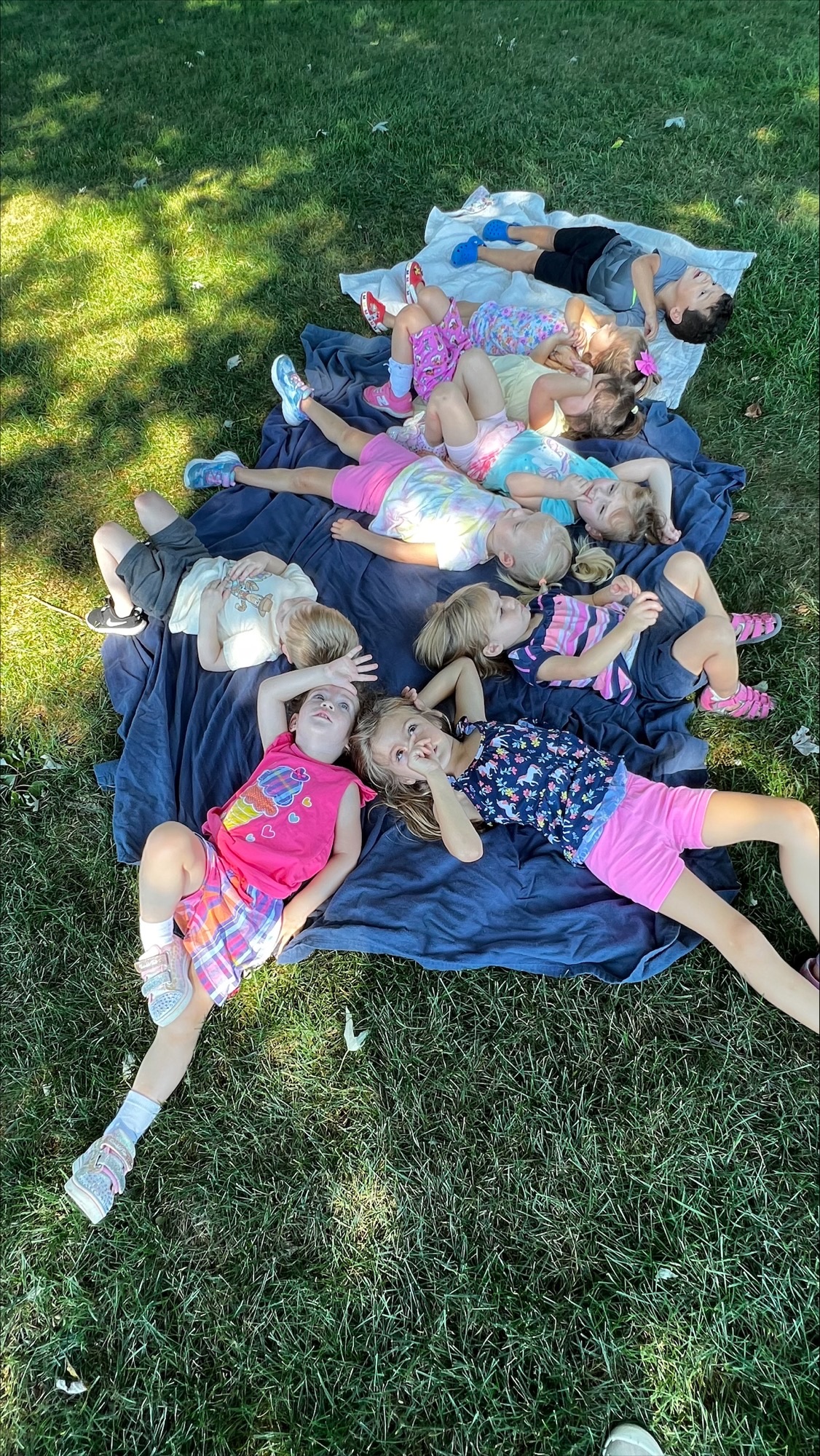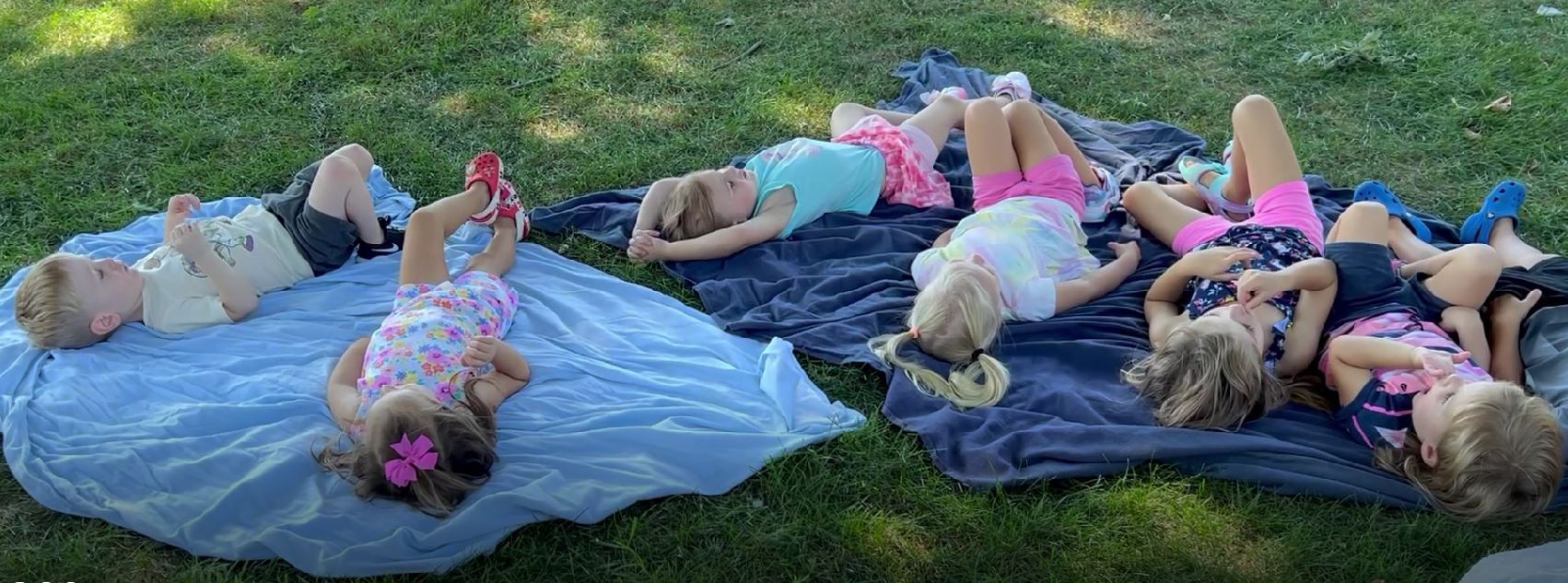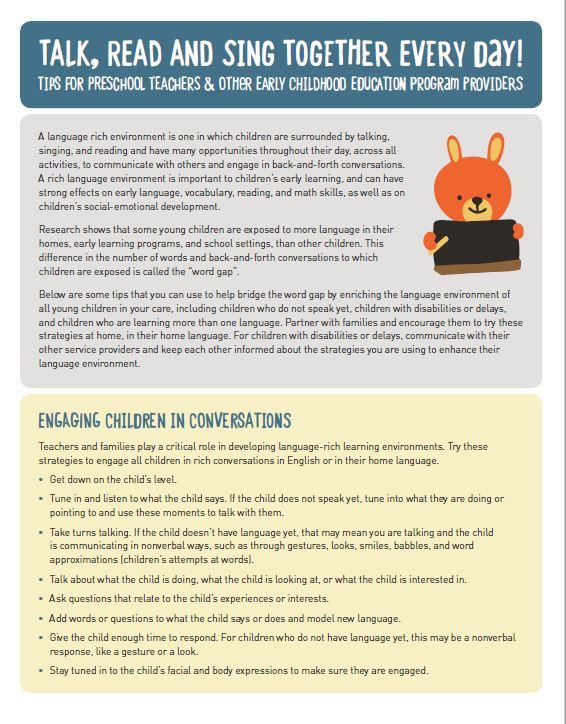Looking for an interesting textural addition to your play dough? Add birdseed and try this no-cook recipe, written to use with young children. Note: Skip the food coloring you might normally use to allow children to really notice the distinct colors of each type of seed.
- 2 ½ cups All-Purpose Flour
- ¾ cup Salt
- 2 tablespoons Cream Of Tartar
- ¼ cup Vegetable Oil
- 1 ¼ cups Boiling Water
- 2 cups birdseed
- Help children measure the dry ingredients.
- In a large bowl, have each child add an ingredient then take turns whisking together the flour, salt and cream of tartar.
- Adult adds the vegetable oil and boiling water, and using a spatula, mix until combined.
- Once it’s cool enough to handle, bring the children back together to knead the playdough in the bowl until it becomes smooth, about 2 minutes. (It may appear wet at first but will dry as you knead and the water gets fully absorbed.)
- Form the dough into a “bowl” and add birdseed to the center. Help children incorporate the seeds into the dough.
Early Childhood Education can have a lot of buzzwords and misunderstandings. This “Philosophy Spotlight” series intends to introduce you to the origins of a number of currently used philosophies directly from the writings of their founders and accomplished practitioners, as well as modern practices and ideas associated with these philosophies. Note that many of the philosophies and philosophers we reference in the US are Euro-centric in origin. I will do my best to integrate philosophies of development and learning from a more diverse body of knowledge, for the benefit of all children and providers. You’ll notice a significant amount of overlap between philosophies, as well as some stark differences. Use these articles to consider your own approach to early education, and maybe refine how you see you work and design your program. These are intended to be broad overviews; please see the references if you’d like to learn more about each one!
Origins: After Italy had been destroyed as a fascist power during World War II, there was a movement to rebuild the country in a way that would support its citizens in pursuit of freedom from oppression. The first Reggio Emilia school was built by families seeking to create a new school for their children as they rebuilt their community. They quickly grew into a network of preschools and infant toddler centers through the 1960s and 70s. In 1991, Newsweek called the Diana school, one of Reggio Emilia’s preschools, one of the best schools in the world.
Modern Regulating Bodies/Standards: The term “Reggio Emilia Approach” is trademarked, leading to many programs describing their philosophy as “Reggio Inspired”, although there is no regulating body outside of Italy that controls the use of the term. A school cannot be certified as a Reggio Emilia school, nor can a teacher be a certified Reggio Emilia teacher. There are organizations in the International Network that further the spread of information about the Reggio Emilia approach, but do not serve as regulators.
Theories and Theorists:
Loris Malaguzzi is considered the founder of the Reggio Emilia approach. He was a psychologist trained in pedagogy and had previously co-founded a school for children with disabilities and learning difficulties. While working there, he was approached to collaborate with the new network of preschools and infant-toddler centers.
Values:
Children are active protagonists in their growing processes: Every child can and has the right to create their own experiences as an individual and member of a larger group.
Progettazione/Designing: Education is shaped by the design of environments, participation, and the design of learning situations. It does not happen to the same degree in predesigned programs or curricula that are premade.
The hundred languages: The Hundred Languages of Children are a metaphor for the potential of children and their thinking and creative processes. It is a central value to honor all of children’s forms of self-expression equally.
No way. The hundred is there: A Poem by Loris Malaguzzi (translated by Lella Gandini)
No way. The hundred is there.
The child
is made of one hundred.
The child has
a hundred languages
a hundred hands
a hundred thoughts
a hundred ways of thinking
of playing, of speaking.A hundred always a hundred
ways of listening
of marveling, of loving
a hundred joys
for singing and understanding
a hundred worlds
to discover
a hundred worlds
to invent
a hundred worlds
to dream.The child has
a hundred languages
(and a hundred hundred hundred more)
but they steal ninety-nine.
The school and the culture
separate the head from the body.
They tell the child:
to think without hands
to do without head
to listen and not to speak
to understand without joy
to love and to marvel
only at Easter and at Christmas.They tell the child:
to discover the world already there
and of the hundred
they steal ninety-nine.They tell the child:
that work and play
reality and fantasy
science and imagination
sky and earth
reason and dream
are things
that do not belong together.And thus they tell the child
that the hundred is not there.
The child says:
No way. The hundred is there.
Participation: Children are welcomed to participate in relationships, in the classroom and community. This is to give children the “feeling of solidarity, responsibility, and inclusion, and produce changes and new cultures” (Reggio Children).
Learning as a process of construction, subjective and in groups: Every child constructs their own knowledge, through conversation, research, and discussion.
Educational research: Adults interacting with children should see themselves as researchers and use their documentation as research into children, groups of children, and learning. Educators should be encouraged to continue constructing and reconstructing their knowledge and practices.
Educational documentation: Adults and children take videos, photos, and work samples to document the learning the children are engaging in. These documents are used to provoke discussion and through between educators, between children, and between educators and children together.
Organization: Time, space, and work are all organized to reflect the values of the school and projects.
Environment and spaces: Interior and exterior spaces are all designed and organized to interact with the people in the space, shape learning experiences, and inspire thought and creativity. Care of the environment is critical, and maintaining the aesthetics of the space is intended to create pleasure and joy in the people who use the space.
Formation/Professional growth: Professional growth is the right of individual educators and the whole group. In Reggio Emilia, professional development is part of educators’ working time, and occurs within staff meetings and the larger city, national, and international context.
Evaluation: The schools should be evaluated frequently by their coordinators, educators, community members, and families to ensure that they are meeting the needs of the children and families.
What You Might Observe in a Reggio Inspired Program:
Many Reggio Emilia inspired programs place a heavy emphasis on the arts, particularly visual representations and planning, along with guided exploration of visual arts materials. There will likely be documentation of children’s work hanging up for children and adults. Oftentimes, children in Reggio Inspired programs use more “loose parts” than traditional toys. As part of the Reggio value of designing, children are offered “provocations” which are curated sets of materials designed for children to explore and experiment with to provoke their thinking and extend their interests. Provocations can look like a tray with small balls and ramps; unwrapped crayons, leaves, and thin paper for printmaking; boxes, tape, and crayons to create with; or anything else that children might use to carry out experiments on their own interests.
Influence on Modern ECE Programs at Large:
Many programs use pedagogical documentation to show families what children have been participating in. Loose parts play is also becoming much more widespread in early childhood programs.
Questions for Your Reflection:
When you think of yourself as not just an educator, but a researcher of children, how does that influence your perspective on your work? What would you do differently as a researcher than as a teacher?
How does documentation differ from any other display of children’s work?
When you think about your environment, does it work with or against your program’s mission and vision? What would you like to change?
Early Childhood Education can have a lot of buzzwords and misunderstandings. This “Philosophy Spotlight” series intends to introduce you to the origins of a number of currently used philosophies directly from the writings of their founders and accomplished practitioners, as well as modern practices and ideas associated with these philosophies. Note that many of the philosophies and philosophers we reference in the US are Euro-centric in origin. I will do my best to integrate philosophies of development and learning from a more diverse body of knowledge, for the benefit of all children and providers. You’ll notice a significant amount of overlap between philosophies, as well as some stark differences. Use these articles to consider your own approach to early education, and maybe refine how you see you work and design your program. These are intended to be broad overviews; please see the references if you’d like to learn more about each one!
Origins: Dr. Montessori was a physician who worked with disabled children, who were at the time isolated in asylums and assumed to be incapable of anything worthwhile. She believed that these children had more potential to be educated, and so she set about creating a method of education (pedagogy) to be used specifically for children with disabilities, with her first school opening in 1898. She quickly realized that typically developing children could benefit from her ideas as well.
Modern Regulating Bodies/Standards: the American Montessori Society offers an accreditation program for Montessori schools, but AMS accreditation is not required for a program to call itself Montessori or use its practices.
Theories and Theorists: “The school must permit the free, natural manifestations of the child” – Maria Montessori
Young children’s options for activities are known as “work,” to give appropriate value to their actions. In modern use, preschool children’s work is separated into the areas of practical life, sensorial, language, mathematics, biology, geography, and fine arts.
Values:
Independence: children in Montessori classrooms are encouraged to work independently, from taking their materials off of the shelf, to competing the work, to placing it back on the shelf the way they found it. They are also taught to prepare and serve their own snacks and clean up after themselves.
Teachers are known as “guides” to highlight their role as a facilitator rather than director.
Children should have freedom to determine what they will work on and for how long.
Materials and environment should be beautiful and convey their importance to children.
What You Might Observe in a Montessori Classroom:
Montessori Materials: While the term “Montessori” is used to sell many items now, the Montessori materials are specific creations by Dr. Montessori and her predecessor, Dr. Édouard Séguin. These include items like The Pink Tower, the Hundred Board, and sandpaper letters. There may be only one way to use the materials. For example, a child may or may not be allowed to build a structure other than the Pink Tower with the Pink Tower blocks, depending on the program.
Like the materials are taught to children in sequence with predictable outcomes, art is taught to young children with discrete skills. Children learn about the colors and their relationship to each other on a color wheel; how to use scissors and glue; hole punching; taking rubbings; and many other fine art skills. Dr. Montessori did not write much about how art was to be used in the classroom, so her followers have interpreted this in a range of ways. In general, you will see art materials displayed in lessons, the same way you would see other materials displayed for children’s use.
Mixed-age grouping: Montessori classrooms typically have children of a variety of ages in them. Often you will find a toddler class for children from approximately 18 months until 30 months. After toddler they’ll move to pre-primary, for three- to six-year-olds. The idea behind this is to allow maximum flexibility for children to develop their abilities as they are ready, rather than on a closed schedule tied to chronological age.
Books (and all materials) emphasize reality. Because young children have trouble distinguishing fantasy from reality, Dr. Montessori believed that the books available to them should be rooted in reality, whether those are purely non-fiction or fictional books about the real world. In a traditional Montessori program, for example, you’re unlikely to see any books about talking animals or imaginary creatures. In general, fantasy play is discouraged, including dressing up in costumes. This does depend somewhat on the individual program and implementation.
Influence on Modern ECE Programs at Large:
Dr. Montessori is the primary reason so many early childhood environments have child-sized furniture. She was also one of the early pioneers of approaches that place emphasis on children being able to touch and manipulate the things they’re learning about. In Dr. Montessori’s Own Handbook, she writes about multicolored carpet squares for children to use for seating– a practice many early childhood spaces use today.
Questions for Your Reflection:
How do you see your role in the with children as compared to a classical Montessori guide?
How are materials used in your program?
What types of materials are available for children in your program?
What role do the children take in the maintenance and preparation of their environment?
When and how do you use explicit instruction to guide children? When and how do they have the opportunity to self-correct or use self-correcting materials?
Early Childhood Education can have a lot of buzzwords and misunderstandings. This “Philosophy Spotlight” series intends to introduce you to the origins of a number of currently used philosophies directly from the writings of their founders and accomplished practitioners, as well as modern practices and ideas associated with these philosophies. Note that many of the philosophies and philosophers we reference in the US are Euro-centric in origin. I will do my best to integrate philosophies of development and learning from a more diverse body of knowledge, for the benefit of all children and providers. You’ll notice a significant amount of overlap between philosophies, as well as some stark differences. Use these articles to consider your own approach to early education, and maybe refine how you see you work and design your program. These are intended to be broad overviews; please see the references if you’d like to learn more about each one!
Modern Regulating Bodies/Standards:
Association of Waldorf Schools of North America offers accreditation for Waldorf schools through High School, and WECAN (Waldorf Early Childhood Assocation of North America) offers membership and allows participating organizations, including Family Child Care Homes, to use the term Waldorf.
Origins, Theories and Theorists:
The first Waldorf school was built in the Waldorf Astoria cigarette factory in Stuttgart, Germany in 1919. The factory owner asked Rudolf Steiner to start a school for his employees’ children after Steiner gave a speech there about social renewal in the wake of World War I. Steiner’s school
Steiner created Anthroposophy, a spiritual belief that aligns with Christianity but is not explicitly Christian. Waldorf schools are still influenced by anthroposophy, but the majority would not consider themselves religious.
“We must delay as long as possible the giving of mental concepts in purely intellectual form…man should fully awaken later in life, but the child must be allowed to remain as long as possible in the peaceful, dreamlike state of pictorial imagination of the early years. For if we allow the organism to grow strong in this way, he will develop in later life the intellectuality needed in the world today.” Rudolf Steiner, 1923
The Waldorf philosophy comes with a specific view of child development, spaced out in three phases of seven years each. Early childhood is thought of as the first seven years of life, and is a time for children to engage with physical materials and explore the world as well as their imagination. It is considered too early for intellectual or academic work.
Values:
Creativity and fantasy– Steiner believed that young children live in a fantasy world, and thus should hear stories that continue to encourage their imagination, so as to develop their intuition. He also believed that fairy tales and other fantastical stories are internalized by children as allegories and accessed later as part of their subconscious spiritual and moral development.
Being outdoors and spending time in nature, observing the changes of the seasons and passing of time through ritual.
Limiting early academics. Children in Waldorf schools do not partake in any formal literacy instruction until first grade, and it is believed that academic expectations are a hindrance to a young child’s development.
Little to no use of electronics/technology, including recorded music, at least until upper grades (mostly high school).
Steiner believed that “the human being is a music being,” and placed great importance on children and adults alike creating music.
“Educating the head, the heart, and the hands” was how Steiner phrased his idea for holistic education. This could also be phrased as thinking, feeling, and doing, and represents educating the whole person. Young children in particular are primarily “hands”– they learn through doing, and active physical exploration.
Great emphasis on creative expression; Waldorf schools incorporate arts and music throughout the curriculum.
What You Might Observe in a Waldorf Early Childhood Program:
Practical life activities similar to Montessori; children are encouraged to help cook and serve food, as is developmentally appropriate.
A lot of art and music. Waldorf teachers and children sing together every day as part of their curriculum, and painting and drawing are valued highly, as are crafts such as felting and knitting, even for young children.
Puppets! Puppet Plays are a significant tradition in Waldorf education, intended to teach children the value of storytelling in different ways. These puppets are often very simple and frequently handmade from knotted cloths or felted wool.
Nature tables: low tables with sticks, leaves, stones, flowers, and other items brought inside from the natural world. The children seek out these objects as symbols of seasonal change; dry brown leaves in the fall are replaced with empty shed twigs in the winter, and then fresh green leaves in the spring.
Influence on Modern ECE Programs:
Many modern early childhood programs place a strong emphasis on story telling with young children. An increasing number are bringing in natural artifacts in a way similar to a nature table.
Questions for Your Reflection:
What in your practice might align with Waldorf values?
How does your view of child development agree or disagree with Steiner?
What ideas in Steiner’s statements or in Waldorf schools as they are today challenge or align with beliefs you hold about young children?
Make your own game of bowling using recycled 1 or 2 liter bottles. make them fun by decorating them with colorful masking tape. Helpful tip, seal the top on with a glue gun so the bottles do not crush easily. Use any ball to knock down the pins.
Goal: Children will develop large motor skills and hand-eye coordination with this activity.
Provide children with a large sheet of butcher paper and small trays or plates with paint to explore dipping and making marks with recycled materials such as toilet paper or paper towel tubes, containers of various shapes and sizes, materials with different textures, etc. This could be an activity that is available over several days that children can experiment with in a variety of ways.
Goal: Children will work collaboratively, use fine motor skills, and explore making marks with paint using a variety of recyclable materials.
Looking at the sky is a simple and relaxing activity that fosters observation and creativity skills. It can change your perspective of the world as you have to explore a broader view. Children can see different animals or flying objects, some we may have missed if we don’t look up. They can also observe cloud formation and shape. Develop their creativity in describing what clouds look like and the stories the clouds are telling us. Next time you are outside, encourage children to look up and explore the sky. You can invite them to this activity by simply laying down a blanket or, if available, providing binoculars!
Research shows the importance of providing children with many language opportunities, including talking, reading, and singing. This tip sheet, created by the U.S. Departments of Education and Health and Human Services in partnership with Too Small to Fail, gives excellent practical tips on facilitating a rich conversation with preschool children, including using questions, expanding the child’s words, and interactive reading!
Tips for language rich -Preschool
Best for infants around 1 mo. Infant should be lying in front of you. Hold your index fingers up to the infants fingers touch gently until they grasps each finger firmly. Gently pull baby forward and watch baby hold on tight, straighten arms and begin to sit forward. Smile and say things like, “look how strong you are”!
Goal: Supports the development of muscle and vision as baby focuses on your voice and face while using their arm and hand muscles.
Encourage children to name animals and then move their body like that animal. They can incorporate sounds as well. You might even make an ‘animal parade’. Talk about the different ways they move their bodies to look like the animal and name the body parts they use. (The book From Head to Toe by Eric Carle is a great resource for this activity).
Goal: Expand children’s vocabulary related to body parts and animal names and move in a variety of ways.







